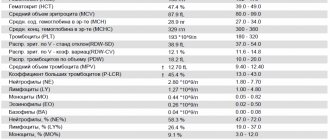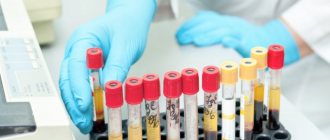There is a standard set of indicators that allows a gastroenterologist or hepatologist to judge the condition of the liver. It includes: enzymes alanine aminotransferase (ALT), aspartate aminotransferase (AST), bilirubin (indirect, direct, total), gamma GT, total protein, alkaline phosphatase (ALP), prothrombin time, prothrombin index and total cholesterol. This set of tests - also called liver tests - is recommended not only for people with pronounced symptoms, but also for those who want to examine the liver prophylactically.
We have already talked about increasing the level of ALT and AST enzymes here. Now let's talk about alkaline phosphatase. What kind of enzyme is this and what can deviations in the amount of ALP indicate? Let's figure it out.
What does alkaline phosphatase show?
The content of the article
Many biochemical processes occur in the human body, including the dephosphorylation reaction. In this case, phosphoric acid is separated from organic ester compounds, participating in calcium-phosphorus metabolism. This process occurs in the presence of the enzyme alkaline phosphatase.
Alkaline phosphatase is an enzyme found in many tissues of the body. But it is mainly concentrated in liver cells, bones, and placenta. The main volume is in the intestinal mucosa.
Alkaline phosphatase is represented in the body by 11 isoenzymes. To determine the cause of elevated alkaline phosphatase, it is also necessary to determine its tissue-specific isoenzymes:
- α2 – liver fraction;
- β1 – bone fraction;
- β2 – intestinal fraction.
Alkaline phosphatase is produced by the upper layer of the intestinal mucosa, but only participates secondarily in the digestive processes. The main function of alkaline phosphatase is dephosphorylation, that is, the separation of phosphoric acid from phosphorus-containing compounds. This enzyme also helps transport phosphorus throughout the body.
The enzyme is called "alkaline" because it is most active in an alkaline environment with a pH ranging from 8.6 to 10.1.
Alkaline phosphatase levels reflect the metabolic efficiency of phosphorus and calcium in the body.
Alkaline phosphatase in children - the norm, reasons for deviation from the norm
Reference values for the alkaline phosphatase test vary with age due to growth.
Normal plasma alkaline phosphatase levels vary by age and gender. Norm for children and adolescents:
| Age | Phosphatase norm |
| Newborns | up to 250 units/d |
| 19 years | up to 350 units/d |
| 10 – 15 years | up to 280 units/l |
| 16 – 19 years old | up to 150 units/l |
Serum levels of this enzyme may vary slightly depending on the testing methods and reagents used.
In pediatric practice, the study of alkaline phosphatase activity plays an important role in the diagnosis of liver diseases, which is complemented by a decrease in the outflow of bile in the duodenum. In addition, the level of alkaline phosphatase in the child's blood is often elevated. High phosphatase levels impair the flow of bile due to bile duct stones or bile duct tumors.
A doctor may make the following diagnoses for a child with elevated alkaline phosphatase:
- bone diseases, including tumors, sarcomas, bone cancer metastases;
- hyperparathyroidism;
- bone damage due to lymphogranulomatosis;
- rickets;
- pediatric diseases - skeletal diseases;
- Infectious mononucleosis;
- myeloma;
- childhood cytomegaly;
- intestinal infections.
The alkaline phosphatase level in children is of great importance in the early diagnosis of rickets. In this case, enzyme activity increases long before the onset of clinical symptoms of the disease.
Sometimes a physiological, that is, natural, increase in the level of alkaline phosphatase in the blood serum occurs: in premature children or adolescents during puberty and intensive bone growth.
Medicines with hepatotoxic side effects may also increase a child's alkaline phosphatase enzyme levels. Such drugs include paracetamol, penicillins, sulfonamides, erythromycin and many others. Increased bone metabolism during bone fracture healing often increases levels of this enzyme.
Decreased alkaline phosphatase enzyme levels are not clinically significant. A decrease in enzyme levels can occur with various bone growth disorders, deficiency of zinc, magnesium, vitamins C and B12 in food, anemia and hypothyroidism, as well as in rare cases of congenital hypophosphatasia.
For what diseases is the index elevated?
In addition to the physiological etiology of increased alkaline phosphatase, pathologies in the body affect the increase in the activity of this enzyme:
- Liver diseases: necrosis of the liver parenchyma, jaundice (hepatitis), neoplasms in a malignant organ, metastases in the liver, as a result of oncology of neighboring organs. Infectious liver diseases, damage to the organ by toxins, and drug intoxication also cause enzyme activity. The enzyme index is affected by parasites that penetrate liver cells and destroy it. Hepatitis, which is caused by viruses, does not produce high isoenzyme activity. Enzyme coefficients may not be higher than normal. The result of the aminotransferase analysis is an increased ALT and AST index,
- The inflammatory process in the gallbladder and ducts is a disease called cholecystitis, or cholangitis. Mechanical jaundice, which was provoked by a calculus blocking the exit from the bile bladder, can also provoke an increase in phosphatase. Bile ducts can be blocked by duct adhesions and neoplasms that are caused by cancer. This pathology causes a sharp jump in the alkaline phosphatase index,
- Oral contraceptives containing progesterone, as well as estrogen, can lead to drug-induced (cholestatic) jaundice, which causes an increase in the phosphatase index in women,
- Intoxication with alcoholic beverages in chronic form,
- Vitamin D deficiency caused by rickets in an infant. Rickets caused by kidney pathology has a congenital etiology,
- Cytomegalovirus infectious pathology in a child,
- Neoplasms of the bile ducts,
- Pathologies that lead to destructive processes in bone tissue: bone sarcoma, metastases that have spread from oncology to neighboring organs. Deviations in the enzyme index are also caused by improperly fused bone after a fracture,
- Pathology osteomalacia deficiency of minerals in bone tissue,
- Leukemia,
- Lymphogranulomatosis,
- Paget's disease is osteitis of a deforming nature. Increased index 20 times the norm,
- Mononucleosis of infectious etiology, the enzyme is increased at the initial stage of infectious inflammation,
- Myeloma disease,
- Pathology in muscle tissue,
- Increased production of thyroid hormones (toxic goiter),
- Hyperparathyroidism, overactivity of the parathyroid glands,
- Oncology of the head of the pancreatic organ,
- Scleroderma,
- Beck's sarcoidosis
- Breast cancer,
- Endometritis of the genital organs in women,
- Oncological neoplasms in the cervix,
- ovarian cancer
- Endometrial disease
- Myocardial infarction in the acute stage of the disease,
- Ulcerative colitis,
- Intestinal perforation,
- Calcium deficiency in the body,
- Phosphorus deficiency.
Calcium deficiency
How to reduce alkaline phosphatase?
Treatment to reduce enzyme activity is carried out using medications and a balanced diet for the patient:
- The drug Azathioprine,
- The drug Clofibrate,
- Oral contraceptives,
- Drugs that normalize liver function
- Use infusions of medicinal plants that have a positive effect on the liver,
- Diet using foods rich in calcium,
- A diet that contains the maximum amount of phosphorus in products: fish, seafood, dairy products, meat, beef liver.
Phosphorus-rich foods
Alkaline phosphatase in adults - the norm, reasons for deviation from the norm
A test to determine the level of enzyme in the blood is carried out in the following cases:
- routine inspection;
- preparation for surgery;
- performing a set of biochemical tests - liver tests to detect liver diseases;
- diagnosis of bone tissue and bone damage;
- if patients complain of heaviness and pain in the right side under the ribs, nausea, loss of appetite and chronic fatigue.
Norm for women
After the age of sixteen, the amount of alkaline phosphatase begins to decline. But the range of its normal concentration is still quite wide.
With the onset of mature and advanced age, the level of enzymes increases again and should be (units/l):
| Woman's age | Phosphatase norm |
| 20-30 years | 85-105 units/l |
| 30-45 years | 95 – 115 units/l |
| 45-55 years | 100 – 125 units/l |
| 55-70 years | 130 – 145 units/l |
| over 70 years old | 165 – 190 units/l |
Norm for men
In adults, the amount of alkaline phosphatase varies slightly depending on gender; for men the norm is 20-25 units/l higher than for women of the same age:
| Man's age | Phosphatase norm |
| 20 – 30 years | 100-115 units/l |
| 30 – 45 years | 135 – 145 units/l |
| 45 – 55 years | 135 – 150 units/l |
| 55 – 70 years | 135 – 160 units/l |
| over 70 years old | 145 – 190 units/l |
Abnormal alkaline phosphatase - causes
The causes of increased alkaline phosphatase levels can be grouped as follows:
- Damage or destruction (destruction) of the liver, problems with the movement of bile:
- viral and autoimmune hepatitis;
- liver pathology caused by toxins and drugs;
- formation of bile in the ducts of stones;
- primary sclerosing cholangitis - manifested by inflammation and narrowing of the intrahepatic ducts;
- Infectious mononucleosis;
- stagnation of bile – cholestasis.
- Pathology of bone tissue:
- osteomalacia or softening of the bones - this systemic damage is characterized by a violation of mineral metabolism and loss of calcium salts, vitamins and phosphoric acid, as a result of which the bones soften and become deformed;
- increased metabolism in bone tissue that occurs during fracture healing;
- Paget's disease - characterized by significant destruction of bone tissue, deformation and weakening of bones, most often affecting men over 50 years of age;
- osteosarcoma and metastases penetrating into bone tissue.
III. Other pathologies:
- primary and secondary hyperparathyroidism are diseases of the endocrine system with severe disturbances in the metabolism of phosphorus and calcium;
- myocardial infarction;
- gastrointestinal pathology.
- Non-pathological reasons:
- alcohol poisoning;
- third trimester of pregnancy;
- lactation;
- the use of drugs with hepatotoxic effects - they can negatively affect the liver and cause structural and functional disorders;
- excessive physical activity;
- poor nutrition and vitamin deficiency;
- possible deviations during childbirth and after menopause vary from person to person.
Exceeding the enzyme norm does not always indicate the type of disease. Perhaps the person is healthy and the increase in alkaline phosphatase is due to physiological properties. Therefore, further tests need to be carried out to determine the exact causes.
Alkaline phosphatase levels are below normal
A decrease in enzyme content can signal the appearance or presence of dangerous diseases in the body.
Reasons for decreased enzyme levels:
- severe anemia;
- hypothyroidism – decreased levels of thyroid hormones;
- significant blood transfusions;
- fetal malformations, for example, placental insufficiency - a common complication of pregnancy;
- frequent use of oral contraceptives;
- hypophosphatasia is a rare but life-threatening disease;
- radioactive contamination - in this case, measuring blood parameters will show the accumulation of radioactive isotopes;
- malnutrition, lack of magnesium, zinc and vitamin C;
- Excess vitamin D can cause a change in the reagent when diagnosing certain diseases, for example, rickets.
When is a blood test for alkaline phosphatase performed?
In clinical practice, alkaline phosphatase levels acquire important diagnostic value only in combination with other laboratory and instrumental studies. Therefore, patients are usually given a biochemical blood test, which includes alkaline phosphatase.
This study is indicated for all outpatient and inpatient patients with impaired liver, kidney, digestive and endocrine system function. Currently, in most cases they are limited to determining the total level of alkaline phosphatase, since fractional analysis, although more informative, is very expensive and is carried out only in specialized laboratories.
Under what circumstances is a study ordered?
Laboratory testing for alkaline phosphatase is standard in biochemical analysis, and is used in preparation for surgery in the body. This testing is also carried out with liver tests.
An alkaline phosphatase test is prescribed when the patient has pronounced symptoms:
- General weakness of the body,
- Decreased appetite
- Nausea that progresses to vomiting
- Pain in the upper abdomen that ricochets to the right side under the ribs,
- Yellowing of the skin due to jaundice,
- Darkening of urine
- Change in the color of feces,
- Itchy skin
- Painful sensations in the bones,
- Joint pain.
Alkaline phosphatase testing is also always performed in cases of frequent bone fractures.
How is the alkaline phosphatase test performed?
To get the correct test result, you must follow these rules:
- the test may be performed in a laboratory, from which a healthcare professional takes a blood sample from the bloodstream and places it in a closed container for testing;
- Blood sampling is carried out in the morning from the ulnar vein in the amount of 5-10 ml;
- the test should be performed on an empty stomach and it is best not to eat for at least 12 hours before taking blood;
- the day before donating blood, you should not engage in heavy physical work or sports associated with severe stress;
- Avoid drinking alcohol and drugs that increase alkaline phosphatase levels.
Typically, test results are ready in 1–2 days.
Features of determining alkaline phosphatase
Blood serum is used for analysis. In most cases, the top layer formed in the separator tube is taken. The activity of this enzyme may vary slightly when blood samples are stored at room temperature. Hemolysis in vitro does not affect the test results.
Preparing for analysis
Venous blood is the material that must be donated for the study. To exclude the influence of various factors, it is necessary to prepare. Preparation is standard for any blood test.
- Blood is donated on an empty stomach. You can drink some water in the morning.
- 3 hours before blood sampling, refrain from smoking.
- The day before the analysis, maintain physical and emotional peace.
- The attending physician should be familiar with the list of medications taken, since there are a number of medications that affect the activity of the enzyme.
What to do if your alkaline phosphatase level is abnormal?
When treating, the etiological direction should be indicated. If you have liver or biliary tract diseases, you should consult a gastroenterologist. The presence of cholestasis, pancreatitis, alcoholic hepatitis or cirrhosis of the liver requires appropriate medical correction, the extent of which is determined only by a doctor. Self-medication in this case can aggravate the underlying disease.
Changes in enzyme levels, including alkaline phosphatase, may occur in heart failure, cancer and serious kidney problems, as well as diabetes, so consult a cardiologist, nephrologist or endocrinologist. The doctor determines treatment tactics depending on the clinical picture.
By eliminating etiological factors, alkaline phosphatase activity is normalized. When prescribing therapy, it should be taken into account that, for example, a physiological increase in this indicator is possible with fractures, active skeletal growth and pregnancy. This does not require medical intervention. Interpretation of laboratory test results should be carried out comprehensively, taking into account other biochemical indicators and patient complaints.
Reduced phosphatase index in the blood
Less release of isoenzymes into the blood serum provokes a decrease in the alkaline phosphatase index.
Alkaline phosphatase is low, which means the following pathologies occur in the body:
- Osteoporosis of old age,
- Thyroid myxedema,
- An excess of radioactive isotopes in bone tissue,
- Severe anemia
- Scurvy or vitamin C deficiency,
- An excess of vitamin D in the body. This indicator is a consequence of non-compliance with the dosage of medications for rickets.
You can increase the presence of alkaline phosphatase in your blood serum using a diet that can saturate the body with essential vitamins:
- Foods high in vitamin C: citrus fruits (especially lemon), onions, garlic, black currants, rose hips,
- Products containing B vitamins: meat, legumes, beef liver, fatty fish, garden herbs,
- Foods rich in magnesium molecules are seeds, legumes, soybeans, nuts of all kinds.
Foods rich in magnesium molecules











